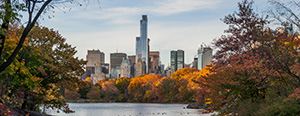Driving across the Lion’s Gate Bridge today, the sense of pride and awe I feel never fails to be the highlight of my morning, as I see the city of Vancouver appear floating on the clouds. The majestic buildings greet me as I join the heartbeat of the city for another day. A tall, uniquely styled building never fails to impress locals and visitors alike in any of the powerful cities around the world, and as technology continues to advance at a rapid pace, we are finding ways to build higher and higher. Not to mention the growing need for urban density, with many of our cities expanding with consistent population growth.
 One new iconic 90-story skyscraper was recently constructed in New York City, the epicenter for urban real estate. One57 as it’s called, has been a part of the two most expensive properties ever sold in NYC – a duplex for $91.5 million, and the penthouse for a little over $100 million. With assets of this magnitude, combined with the complications of having people living so high in the sky, there is one drawback – how is a building like this effectively protected from the breakout of a fire?
One new iconic 90-story skyscraper was recently constructed in New York City, the epicenter for urban real estate. One57 as it’s called, has been a part of the two most expensive properties ever sold in NYC – a duplex for $91.5 million, and the penthouse for a little over $100 million. With assets of this magnitude, combined with the complications of having people living so high in the sky, there is one drawback – how is a building like this effectively protected from the breakout of a fire?
Many commercial, industrial and institutional buildings have water storage vessels to supply or supplement its fire sprinkler systems. These tanks may often be located on the roof or on a floor near the top of the structure to allow gravity to help deliver water suppression.
Fire suppression tanks can also be buried underground or in the basement of a structure, in a pressurized vessel or a pump station.
However, these tanks have issues, such as:
- Steel tanks are subject to corrosion
- If concrete tanks crack, leaks cause corrosion and deterioration
- Wooden tanks develop decay (rot) on the interior surfaces
All these problems can be addressed by properly waterproofing and improving the concrete so that the issues above don’t become systemic problems. A crystalline waterproofing system, like Kryton’s Krystol Internal Membrane (KIM) admixture is vital in ensuring that the water tank – and the properties beneath it – is fully protected.
In One57, Kryton’s KIM was used to waterproof the building’s massive concrete tank, located on the 75th floor (of a total of 90). The tank sits on a suspended slab and is used for the fire suppression of the high units of the building. Using KIM to waterproof the concrete allows the suppression system to have the advantage of durable concrete that will last the life of the structure, with the internal waterproofing only growing stronger, and more effective over the life of the structure.
The next time I am in Manhattan, driving over the Queensboro Bridge, I look forward to seeing One57 as part of the collection of enchanting Manhattan high rises that grace the NYC skyline.






